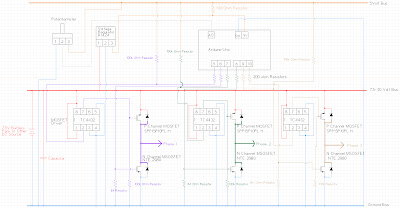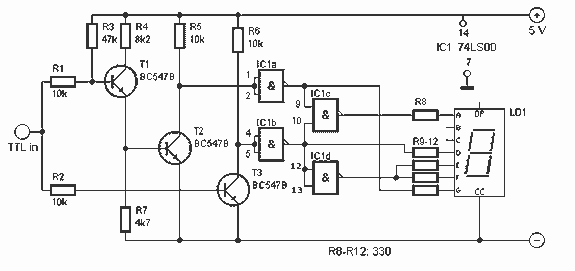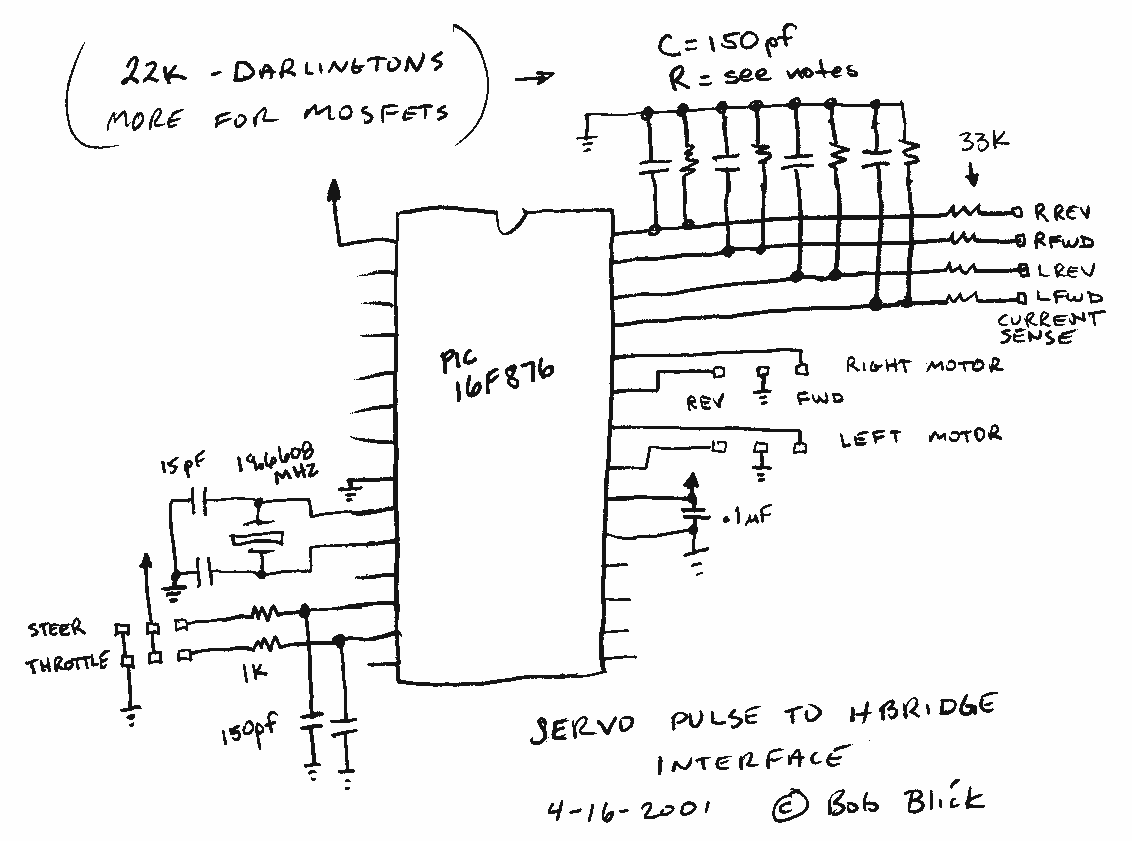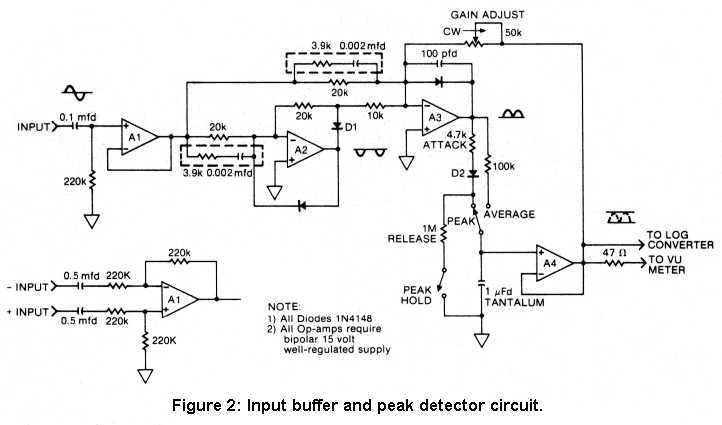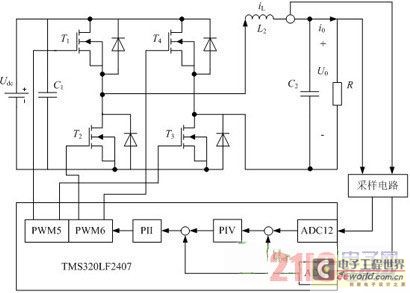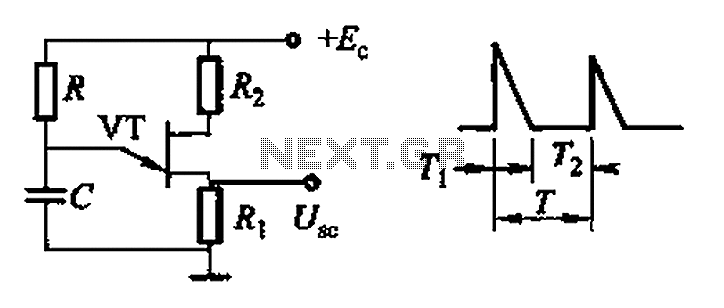
Pulse Reading Logic Probe
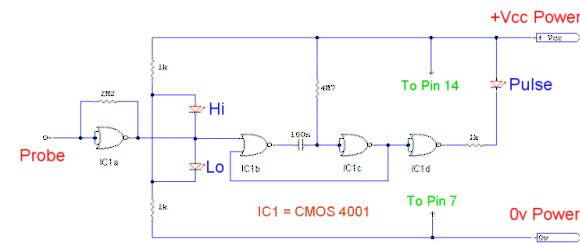
This logic probe utilizes a single CMOS integrated circuit (IC) to indicate three logic states: High, Low, and Pulsing. If the probe input is in a high impedance state, which occurs when it is not connected to a circuit, no LEDs will illuminate. The probe derives power from the logic circuit being tested, and the use of a CMOS IC allows for testing logic circuits with supply voltages ranging from 3 to 15 volts. The first gate (IC1a) operates as a buffer with a unique configuration. In the absence of an input (i.e., when the probe is not connected), the gate will oscillate due to feedback from a 2.2 MΩ resistor, resulting in an output voltage at IC1a that is approximately half of the supply voltage. The high and low logic indicator LEDs are connected to a voltage divider formed by two 1 kΩ resistors. The voltage at the junction of these resistors is also half of the supply voltage, which means that under conditions of no input or high impedance, no LEDs will light up. When a High or Low logic condition is present, IC1a stabilizes in a state that causes either the High or Low LED to illuminate. If a fast oscillator or clock signal is applied, both the High and Low LEDs will light up, albeit dimly. This is where IC1b and IC1c come into play; these two gates create a monostable oscillator with a time constant determined by a 100 nF capacitor and a 4.7 MΩ resistor. When a clock signal is present, the monostable oscillator is continuously triggered and retriggered, effectively slowing down the output. Finally, IC1d functions as a buffer to drive the pulsing LED.
The logic probe circuit is designed for versatility and efficiency in testing digital logic levels. The CMOS technology allows for a wide operational voltage range, making it suitable for various logic families. The buffer configuration of IC1a is crucial for isolating the probe from the circuit under test, ensuring that the probe does not affect the logic levels being measured. The oscillation in the absence of an input serves as a useful diagnostic feature, indicating that the probe is operational and ready for use.
The integration of the monostable oscillator (formed by IC1b and IC1c) is a key enhancement, allowing the probe to handle rapid signal changes effectively. The time constant, determined by the selected capacitor and resistor, can be adjusted to cater to different signal frequencies, thus providing flexibility for the user. The output from the monostable oscillator ensures that even fast pulse signals can be visually represented by the LEDs, allowing for quick identification of signal conditions.
Overall, this logic probe design is a robust and efficient tool for electronics engineers and technicians, providing clear visual indicators for logic states and facilitating the testing of digital circuits across a range of supply voltages.This logic probe uses a single CMOS IC and shows three logic conditions, High, Low and Pulsing. In addition if the probe input is neither hi or low (the high impedance state of tri-output logic ic`s) then no LED`s will light. Power from the logic probe is taken from the logic circuit under test; using a CMOS IC enables logic circuits to be tested
using voltages from 3 to 15 volts. IC1a is arranged as a buffer with a difference. Under no input, i. e. probe not connected to circuit the gate will oscillate due to feedback from the 2M2 resistor. Output voltage at IC1a is approximately half supply voltage. The Hi and Lo logic indicator LED`s are also connected to a potential divider consisting of the two 1k resistors. Voltage at the junction is half supply voltage hence with no input, or high impedance no LED`s will light.
A Hi or Lo logic condition will cause IC1a to rest in a permanent state indicated by either the Hi or Lo LED illuminating. With a fast oscillator or clock signal both Hi and Lo LED`s will light but will be quite dim. This is the reason for IC1b and IC1c. These two gates form a monostable oscillator, time constant determined by the 100n capacitor and 4M7 resistor.
With a clock signal this is effectively slowed as the monostable is continually triggered and retriggered. IC1d acts as a buffer to drive the pulsing LED. 🔗 External reference
The logic probe circuit is designed for versatility and efficiency in testing digital logic levels. The CMOS technology allows for a wide operational voltage range, making it suitable for various logic families. The buffer configuration of IC1a is crucial for isolating the probe from the circuit under test, ensuring that the probe does not affect the logic levels being measured. The oscillation in the absence of an input serves as a useful diagnostic feature, indicating that the probe is operational and ready for use.
The integration of the monostable oscillator (formed by IC1b and IC1c) is a key enhancement, allowing the probe to handle rapid signal changes effectively. The time constant, determined by the selected capacitor and resistor, can be adjusted to cater to different signal frequencies, thus providing flexibility for the user. The output from the monostable oscillator ensures that even fast pulse signals can be visually represented by the LEDs, allowing for quick identification of signal conditions.
Overall, this logic probe design is a robust and efficient tool for electronics engineers and technicians, providing clear visual indicators for logic states and facilitating the testing of digital circuits across a range of supply voltages.This logic probe uses a single CMOS IC and shows three logic conditions, High, Low and Pulsing. In addition if the probe input is neither hi or low (the high impedance state of tri-output logic ic`s) then no LED`s will light. Power from the logic probe is taken from the logic circuit under test; using a CMOS IC enables logic circuits to be tested
using voltages from 3 to 15 volts. IC1a is arranged as a buffer with a difference. Under no input, i. e. probe not connected to circuit the gate will oscillate due to feedback from the 2M2 resistor. Output voltage at IC1a is approximately half supply voltage. The Hi and Lo logic indicator LED`s are also connected to a potential divider consisting of the two 1k resistors. Voltage at the junction is half supply voltage hence with no input, or high impedance no LED`s will light.
A Hi or Lo logic condition will cause IC1a to rest in a permanent state indicated by either the Hi or Lo LED illuminating. With a fast oscillator or clock signal both Hi and Lo LED`s will light but will be quite dim. This is the reason for IC1b and IC1c. These two gates form a monostable oscillator, time constant determined by the 100n capacitor and 4M7 resistor.
With a clock signal this is effectively slowed as the monostable is continually triggered and retriggered. IC1d acts as a buffer to drive the pulsing LED. 🔗 External reference
